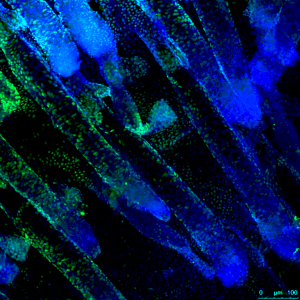Two proteins safeguard skin stem cells

Image: Lorenzo Rinaldi, IRB Barcelona
Our skin renews, heals wounds, and regenerates the hair that covers it thanks to a small group of stem cells. These cells continually produce new ones, which appear on the skin surface after a few days. A study led by CRG Alumnus and ICREA researcher Salvador Aznar Benitah undertaken at the Institute for Research in Biomedicine (IRB Barcelona) has identified two proteins that are fundamental to conserve skin stem cells and has shown that without these proteins these cells are lost. The study, which has been published today in Cell Stem Cell, has involved Luciano Di Croce’s groupat the Centre for Genomic Regulation (acronym in Spanish CRG).
The proteins identified, Dnmt3a y Dnmt3b, are crucial for the self-renewal of skin stem cells as they trigger the first step of the genetic programme of these cells. “Without them, this programme is not activated and the stem cells collapse and disappear from the tissue,” explains Salvador Aznar Benitah, head of the Stem Cells and Cancer lab at IRB Barcelona.
Lorenzo Rinaldi, a “la Caixa” PhD student, also a CRG Alumnus, and first author of the study, has identified all the regions of the genome that harbour these proteins. Rinaldi has observed that these two proteins exert their activity on gene enhancers and superenhancers—regions far away from the genes that can increase gene transcription speed up to 200-fold—among other regions.
“It was surprising to see that two proteins that have always been associated with gene repression through DNA methylation are activated in the most transcriptionally active regions of stem cells. We had never observed this activity because we were unable to study the global distribution of Dnmt3a and Dnmt3b at the genomic level. Thanks to advances in sequencing techniques, more researchers are observing the very mechanism that we have described,” explains Rinaldi.
Of the 12,000 gene enhancers in the genome, about 300 are superenhancers related to stem cells. The two proteins exert their function in these regions in order to trigger the approx. 1,000 genes required for the self-renewing capacity of stem cells. By methylating the superenhancer, these proteins trigger the first step of the machinery that leads to the amplified expression of these essential genes for the stem cell.
Link to cancer
There are various features related to cancer cells. Among these, first, these cells show altered DNA methylation. Second, gene enhancers are highly mutated, not only in the bodies of the genes themselves. These observations have been made possible thanks to mass sequencing of tumour cell genomes. Third, these two proteins, Dnmt3a and Dnmt3b, are altered in many types of tumour, such as those encountered in leukaemia, the lung, and the colon.
“Each of these three components is associated with the development of various kinds of cancer. Given that these proteins activate gene expression enhancers through DNA methylation, we believe that it would be of interest to study them in cancer cells in order to determine whether they participate in tumour development,” concludes Dr. Aznar Benitah.
The study has been funded by the Spanish Ministry of Economy and Competitiveness and ERDFs. Dr. Aznar Benitah’s lab is also supported by The European Council for Research (ERC), the Worldwide Cancer Research Foundation, the Fundació Marató de TV3, the Fundación Vencer el Cáncer, the Fundación Botín and the Government of Catalonia.
Reference:
Lorenzo Rinaldi, Debayan Datta, Judit Serrat, Lluis Morey, Guiomar Solanas, Alexandra Avgustinova, Enrique Blanco, José Ignacio Pons, David Gomez Matallanas, Alex Von Kriegsheim, Luciano Di Croce, and Salvador Aznar Benitah.
"Dnmt3a and Dnmt3b Associate with Enhancers to Regulate Human Epidermal Stem Cell Homeostasis"
Cell Stem Cell (28 July 2016)
Dernière mise à jour: